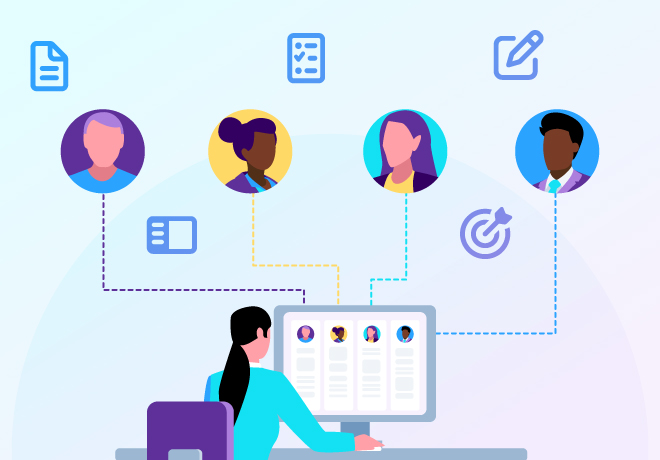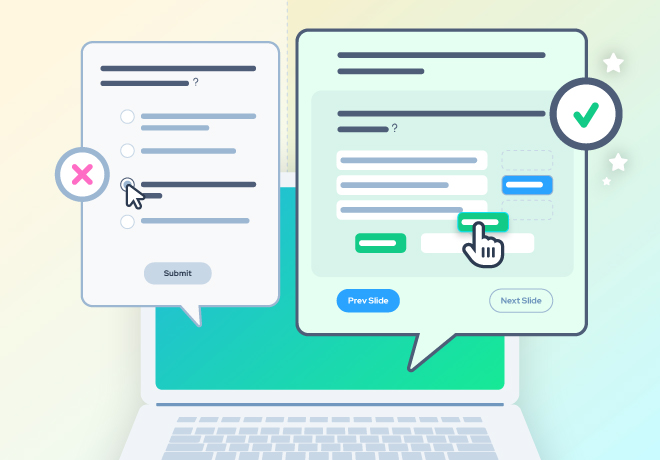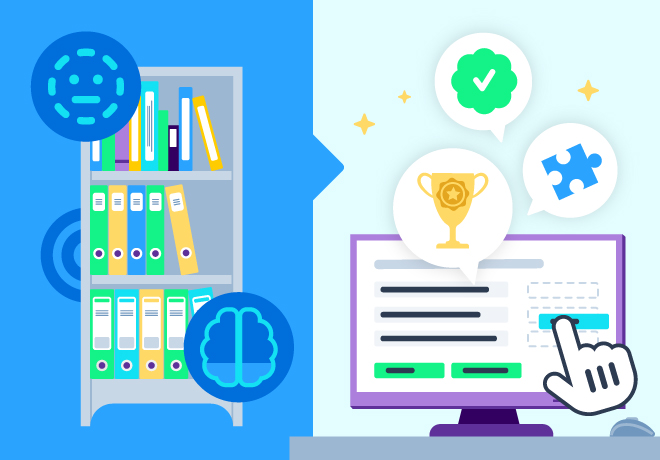Glossary of eLearning Terms
Never miss an article!
Staying up-to-date has never been easier — subscribe to our mailing list for the latest eLearning articles, delivered right to your inbox.
We process your information according to our privacy policy. By submitting this form, you authorize us to communicate with you.
The practice of designing and developing online content that recognizes and supports the various ways learners will use to interact with and understand course content according to Web Content Accessibility Guidelines. Accessibility factors include providing close captioning and transcripts, appropriate contrast and color, optimizing content for screen readers, providing alternatives for mobility barriers, and testing your course for accessibility.
Usually based on AI algorithms, adaptive training delivers specific online training content to each learner based on that learner’s performance in training.
Learners engage with learning content at any time, whether self-directed or structured content.
A software package that makes building eLearning modules and other online training content easy and consistent, generally using templates.
A study program that combines instructor-led training with eLearning. The ILT can be in-person or online (see: virtual classroom and hybrid learning) and the eLearning can be synchronous or asynchronous.
A training or educational approach that asks learners to practice applying one concept at a time or complete problem sets that address only a single concept or process. Contrast with interleaved learning.
Bloom’s Taxonomy is a well-known method of classifying learning objectives according to the different levels of thinking skills required. Bloom’s Digital Taxonomy is a 2008 update and extension to the taxonomy that added verbs to address forms of learning and creating that reflect the digital age, such as blogging, podcasting, or coding.
Multiple responses or paths a learner may choose between, within an eLearning course, interactive video, or other types of online training.
Cognitive load refers to the demands placed on a learner’s working memory when processing content. If content is written in unclear or complex language, if the visual design is cluttered or incoherent, if the content includes a lot of moving graphics and animations, the learner must work hard to sort out the relevant pieces from the decorative elements — and therefore has less mental energy to focus on the content itself. This can lead to cognitive overload, where learners fail to understand key content because their energy is spent simply trying to access or understand it.
Training intended to teach employees about internal organization policies or ensure that employees meet mandatory training requirements set by law, industry regulators, or professional licensing or certification bodies. Some regulations require that compliance training be completed at regular intervals, such as annually.
An early name for online training.
A standalone software or plugin that provides you with a simple interface for building eLearning and digital training, allowing easy integration of interactivity and multimedia with a learning management system (LMS) or delivery through the web.
Examples: Articulate Storyline, Adobe Captivate, and iSpring. An example of a plugin authoring tool is the H5P plugin for learning management systems.
A process of selecting content to share with learners or include in eLearning; the content is vetted for accuracy, trustworthiness, and applicability to the target audience. Curated content is generally maintained so that outdated content is removed and learners can be sure of finding current, high-quality content.
Learning and training that occurs using digital resources, primarily online, though some can be downloaded and used without an active internet connection.
An early name for online training or online learning.
The forgetting curve, based on memory experiments that German psychologist Hermann Ebbinghaus conducted in the late 1800s, is the idea that people quickly forget much of what they have learned — and continue to forget more over time. Spaced repetition can help learners remember content and “flatten” the forgetting curve.
A popular synonym for online training or online learning.
An emerging term that recognizes that learning occurs throughout an employee’s tenure at a job. Compare with onboarding.
An instructional approach that moves passive learning elements, such as readings or lectures, outside of synchronous class time — converting lectures to on-demand videos, for example — and uses synchronous learning time for active learning, such as problem solving, projects, and other analytical activities or tasks requiring learners to apply content they’ve learned.
Information about a learner’s progress or whether a response was correct or incorrect — and why — that is provided during the training exercise, rather than at the end (summative feedback).
An approach to creating learning content in the form of a game, building in game elements such as competition against others or oneself, a set of rules and the use of rewards and penalties to encourage play and measure progress and mastery.
Adding game elements to learning content with the goal of making learning fun and engaging, appealing to learners’ sense of competition, or motivating learners to spend more time on training.
Types of similarly featured software used by Human Resource professionals to manage various aspects of their work. Features may include, but are not limited to: payroll management, benefits administration, compliance tracking, and records storage. An HRMS is used more specifically for talent and performance management than administrative tracking. An online training platform may need to be integrated with a company’s HRIS/HRMS for ease of data transfer.
An approach to learning that combines in-person with virtual learning at the same time. That is, an instructor addresses both learners who are present with them in the classroom and learners who are at remote locations. Everyone is learning synchronously. See also blended learning.
eLearning that takes place within a simulated or virtual environment, such as virtual reality.
Synchronous learning or training that is taught by an instructor, in real time, usually with multiple learners in a physical classroom or a virtual classroom (online) — this would be referred to as VILT. Class size can vary from a few to hundreds of learners.
Interactivities in eLearning include any type of action that requests input from a learner in order to progress. This can be either through course materials, to produce a result, or to achieve a goal (such as passing a test). Some popular examples of interactivity include quizzes and knowledge checks, drag-and-drop or click-to-reveal activities, scenarios, simulations, videos, and augmented reality. There are four levels of interactivity in eLearning: Passive, Simple, Moderate, and Complex.
An approach to presenting learning content that mixes related concepts and asks learners to apply related concepts and processes in mixed problem sets. Contrast with blocked practice.
A series of questions presented to learners before, during, or after their training to gauge their level of knowledge. These checks are typically used as a self-assessment and not for calculating learners’ grades
An addition to a training program that builds in eLearning or performance support to ensure that learners remember — or retain — essential content, rather than covering it once, passing a test, and then forgetting most of the material. It might include spaced repetition, performance support, or workflow learning.
A big-picture view of training that encompasses content — as well examining the learners’ background, prior knowledge, and environment. The goal of considering LX is to provide an overall experience that supports learning, mastery, and retention of training content. LX design considers the delivery medium, the user interface, visual design, accessibility, cognitive load, appropriateness of the content and medium for the learners’ environment and needs
Designed to offer a more personalized learning experience and to help users discover new learning opportunities. Some LXPs combine content from a variety of different sources or creators and deliver them with the assistance of complex artificial intelligence. An LXP acts as a curator, repository, and dispenser of learning content and learning records in a highly personalized and comprehensive training experience.
The collection, measurement, analysis, and use of data gathered about learners’ participation in training, including completion, performance, quiz scores.
An LMS or learning management system is a platform that manages eLearning materials — hosting course content and resources, a search function, an online learning space, and a way for learners to find, enroll in, and take courses. An LMS usually includes a way for administrators to manage courses, content, enrollment, and assessment of learning.
An evaluation of all aspects of your company’s training materials to ensure they are delivering the right information for their trainees and to find any gaps that exist within the materials themselves. Compare with training needs analysis.
Part of an xAPI ecosystem that enables the collection and storage of learning data from places where learning occurs. The xAPI standard makes it possible to create statements about learning activities far beyond the course completions, engagement time, and test scores that a SCORM-based LMS gathers, such as: viewing a video, reading an article, completing an activity, or participating in a simulation. These data statements are stored in the LRS.
Short, narrowly focused learning content, generally digital and available online, though infographics and short printed texts could also be considered microlearning. Each unit of microlearning addresses a single concept or idea. Microlearning is usually mobile-first or mobile-friendly, enabling learners to use it anywhere, on their favorite digital devices.
eLearning designed and optimized for use on mobile devices, particularly smartphones and tablets. Mobile-friendly content is designed to work well on mobile devices but is designed primarily for laptop and desktop use.
Orientation and training of new employees; onboarding eLearning could include guiding new hires through processes like signing up for a retirement plan; providing information about company policies; providing orientation and training in basic tasks related to their job role or employment, etc. Onboarding is generally conducted during the employee’s first week or month in a job. Compare with everboarding.
Any form of instruction that takes place completely on the internet. It can be text-based and include graphics, video, and audio, as well as animations, simulations, and other interactive elements as complex as augmented or virtual reality components. May also be known as computer-based training (CBT), distance learning, or eLearning.
A type of software that is freely available for anyone to use, modify, and distribute. Open-source software is typically developed and maintained by a community of volunteers rather than a single company or organization. Often these tools are a great option for budget-conscious users, though it is worth noting that these tools may not have the same level of support or resources as proprietary tools and users may have to rely on community forums or other online sources for help.
Job aids or tools that permit employees to look up information they need within their workflow, rather than going to training or taking an eLearning course. Performance support can include just-in-time training or workflow learning, reference materials, curated content and other tools available on-demand at the moment of need.
A learner persona is an archetypal learner — a fictional person who represents a slice of the learner population. A persona generally includes a name, age, ethnic and gender identity, likes and dislikes, and a “work” history and job role. They might also have a fictional family, hobbies, and personality traits and quirks.
The persona gives instructional designers a target — if the persona is someone who is not tech-savvy, for example, the designers might take more care in designing an intuitive user interface.
A learning approach that enables each learner to exercise control over the learning environment. In eLearning, this often means choosing when to do training, often choosing the courses to take, and possibly choosing a format for content — choosing between text and video-based content, for example.
Teaching workers new skills to prepare them to take on new responsibilities or change roles within an organization. Compare with upskilling.
Training that uses scenarios to describe or simulate realistic situations that learners could face on the job. Scenarios provide practice preparing for and working through these situations, ranging from retail workers coping with Black Friday crowds to bank tellers teaching customers to use the bank’s mobile app to deposit a check. Scenarios may include branching.
The Shareable Content Object Reference Model is a standard for creating eLearning that works with other eLearning and with most LMSs (learning management systems). SCORM compliance has become the industry default for interoperability.
Asynchronous learning that a learner undertakes voluntarily and under their own control, choosing the time, place, means, format, and content of the learning.
Formal and informal channels for learning collaboration and communal learning; social learning platforms exist that connect learners both within an organization (e.g., your office’s Slack channels) and among professional peers outside the company (e.g., LinkedIn).
An approach to learning that recognizes that exposing learners to content or information a single time is insufficient, spaced repetition describes training and retention strategies that ensure that each learner gets multiple exposures, over time, to important information. The intervals between exposures — the spaces — can grow larger as learners become more familiar with the material.
A simple visual representation of an online course and its content. A typical storyboard for an eLearning course includes course content, assessment questions and feedback, instructions for interactivity, and instructions for design elements. The storyboard will also capture narration scripts.
Information about a learner’s progress or whether a response was correct or incorrect — and why — that is provided at the end of training or a course, rather than during the training (formative feedback). Summative feedback is often provided along with the results of a summative assessment, otherwise known as a final exam.
Learners engage with content, and, usually, an instructor, simultaneously. Synchronous learning can occur in a physical classroom or online. See virtual classroom.
A process for understanding your organization’s training strengths and weaknesses based on an impartial assessment of your strategy, existing content, delivery mechanisms, and the impact on your KPIs.
An evaluation of your company’s training strategy to ensure that the resultant training objectives will meet the organization's overall needs. Compare with learning needs analysis.
A design process that focuses on making the designed object usable by the broadest variety of users, in the widest range of situations — without requiring adaptations or workarounds. When applied along with user-centered design, multiple users or user personas are considered to ensure a broadly focused and usable end product.
Teaching employees new skills to prepare them to take on new responsibilities or change roles within an organization. Compare with reskilling.
UX or user experience, similar to LX or learner experience, describes the way a user or learner interacts with training or eLearning or a learning game. It encompasses user interface (UI), navigation, content flow, and logistics.
An approach to design, whether of training content, other online content, physical objects, or buildings, that considers the user in every aspect. It examines the context in which the designed object will be used, who will use it, how they will use it, and under what conditions they will use it.
For eLearning design, that might mean considering whether learners will use training at an office desk, on a retail or warehouse floor, or during their commute; whether their environment will be noisy; how much time they have available for training; any barriers, such as a multilingual learner population or learners who have limited access to technology, etc. The “user” may be based on actual user testers, or it may use a learner persona — or multiple personas — to ensure a broader learner population can benefit from the training product.
An online learning environment that allows for synchronous learning with an instructor and multiple learners participating simultaneously, from different locations.
Training or performance support that workers can use, search, and access on demand, while they are working — without going to training or stopping their work to take an eLearning course. Workflow learning and performance support help employees do their jobs better, with minimal interruption.
An emerging standard for learning technology that makes it possible to collect learning analytics data from learning activities that take place outside of an LMS, using any xAPI-compatible device.
Become part of our L&D community
We publish a new learning hub article — full of useful, practical topics — weekly.
Not sure where where you want to start? Jump into one of our recently published articles and see where it takes you!




-svg.svg)
-svg.svg)
-svg.svg)
-svg.svg)